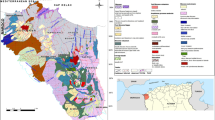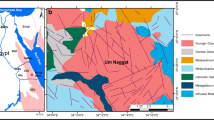Abstract
The Kadavur basin is located in the Southern Granulite Terrain, central part of Tamil Nadu, India. The basin structure and presence of anorthositic formation in the Kadavur are interesting features for many researchers. Anorthosite is an important igneous rock, with limited coverage on earth crust, and commonly present on lunar surface. The origin and emplacement of anorthosite in terrestrial environment are always a matter of interest among geoscientist. In the present study, moderate-resolution IRS P6 LISS III multispectral satellite data are used to interpret the lithology, structure and morphology of the Kadavur basin. The processed satellite outputs show contrast signatures for various rock types such as anorthosites, gabbro, quartzite, gneiss, augen gneiss and charnockites. The lithological and structural details collected during the field investigation were used for mapping. The DEM-generated image shows detail information on structural features including crust line, dipping beds and fault zone in the Kadavur basin. The circular quartzite ridges formed as major structural hill systems, dipping vertically inward toward the center of the basin. The lineation indicates the axis of the fold structure standing on edge or plunging very steeply. The various theories proposed for the origin of structural basin and emplacement of gabbroic anorthositic plutonic body in the Kadavur basin are discussed.










Similar content being viewed by others
References
Abrams, M. J. (1984). Landsat 4 thematic mapper and thematic mapper simulator data for a porphyry copper deposit. Photogrammetric Engineering and Remote Sensing, 50, 1171–1173.
Anbazhagan, S. (1991). Study of geology and structure of Perungulathur area in Thiruvannamalai Sambuvarayar district, Tamil Nadu, using remote sensing techniques. Journal of the Indian Society of Remote Sensing, 19(2), 135–140.
Anbazhagan, S., & Arivazhagan, S. (2010). Reflectance spectra of analog basalts; implications for remote sensing of lunar geology. Planetary and Space Science, 57, 1347–1358.
Anbazhagan, S., Sainaba, N. K., & Arivazhagan, S. (2012). Remote sensing study of Sittampundi anorthosite complex, India. Journal of the Indian Society of Remote Sensing, 40(1), 145–153.
Anbazhagan, S., Uma Maheswaran, S., Arivazhagan, S., & Sisodia, M. S. (2011). Remote sensing study of Kadavur structure—A possible analog site for lunar highland region-preliminary approach. In Conference on planetary sciences and exploration, 12–14 December 2011, PRL, Ahmedabad, India. Abstract. p. 22.
Arumugam, M., & Senthilkumar, R. (1998). Is anorthosite around Kadavur (Karur district, Tamil Nadu)—A diapiric intrusion? The Indian Mineralogist, 32, 35.
Balk, R. (1937). Structural behaviour of igneous rocks. Memoir of the Geological Society of America, 5, 93–94.
Chatterjee, S. C. (1936). The anorthosites of Bengal (p. 46). Calcutta: Calcutta University Press.
Crippen, R. E., & Blom, R. G. (2001). Unveiling the lithology of vegetated terrains in remotely sensed imagery. Photogrammetric Engineering and Remote Sensing, 67(8), 935–946.
Drury, S. A. (1987). Image interpretation in geology (p. p243). London: Allen and Unwin.
Frei, M., & Jutz, S. L. (1989). Use of thematic mapper data for the detection of gold bearing formations in the eastern desert of Egypt. In Proceedings of the 7th thematic conference on remote sensing for ore exploration geology II (pp. 1157–1172).
Ghosh, J. G., de Wit, M. J., & Zartman, R. E. (2004). Age and tectonic evolution of Neoproterozoic ductile shear zones in the Southern Granulite Terrain of India, with implications for Gondwana studies. Tectonics, 23(3), TC3006. https://doi.org/10.1029/2002TC001444.
Gupta, R. P. (2005). Remote sensing geology (2nd ed.). Berlin: Springer.
Hussain, S. M., Narayana, B. L., & Naqvi, S. M. (1996). Geochemistry anorthosites from Kadavur, Tamil Nadu. In N. G. K. Murty, & V. Ram Mohan (Eds)., Charnockites and granulite facies rocks, Geologists Association of Tamil Nadu (pp. 339–349).
Janardhan, A. S., & Weibe, R. A. (1985). Petrology and geochemistry of the Oddanchatram anorthosite and associated basic granulites, Tamil Nadu, South India. Journal of the Geological Society of India, 26, 143–176.
Jenson, J. R. (2005). Introductory digital image processing (3rd ed.). Upper Saddle River: Pearson Prentice Hall.
Kooijman, E., Upadhyay, Dewashish, Mezger, Klaus, Raith, Michael M., Berndt, Jasper, & Srikantappa, C. (2011). Response of the U–Pb chronometer and trace elements in zircon to ultrahigh-temperature metamorphism: The Kadavur anorthosite complex, southern India. Chemical Geology, Elsevier, 290, 177–188.
Kruse, F. A., & Dietz, J. B. (1991). Integration of diverse remote sensing data sets for geological mapping and resource exploration. In Proceedings of SPIE—The international society for optical engineering, earth and atmospheric remote sensing (Vol. 1492, pp. 326–337).
Ramasamy, S. M., Venkatasubramanian, V., & Anbazhagan, S. (1993). Reflectance spectra of minerals and their discrimination using thematic mapper, IRS and SPOT multispectral data. International Journal of Remote Sensing, 14(16), 2935–2970.
Sarkar, A., & Bose, M. K. (1978). Observation on the Kadavur igneous complex, Tiruchirapalli, Tamil Nadu. Indian Journal of Earth Sciences, 55, 194–199.
Subramaniam, A. P. (1956). Petrology of the anorthosite–gabbro mass at Kadavur, Madras, India. Geological Magazine, 93(04), 287–300.
Subramanian, K, S., & Selvan, T. A. (2001). Geology of Tamil Nadu and Pondicherry. The Geological Society of India. ISBN: 81-85867-47-X, p. 192.
Teale W (2010) Structure, geochology and geochemistry of Kadavur dome, Southern India. University of Adelaide, Ph.D thesis (unpublished) p 125.
Teale, W., Collins, A. S., Foden, J., Payne, J. L., Plavsa, D., Chetty, T. R. K., et al. (2011). Cryogenian (~ 830 Ma) mafic magmatism and metamorphism in the northern Madurai Block, southern India: A magmatic link between Sri Lanka and Madagascar? Journal of Asian Earth Sciences, 42(2011), 223–233.
Teillet, P. M. (1995). The role of surface observations in support of remote sensing. In: E. F. LeDrew, M. Strome, & F. Hegyi, (Eds.), Canadian journal remote sensing, contribution to understanding global change, no. 38 (pp. 333–352). University of Waterloo.
Vogt. (1927). Sulitemafeltets geologi og petrografi (Geology and petrology of the Sulitelma district. English summary), Norg. Geol. Undersok, Nr. 121, pp 449–560.
Weaver, B. L., Tarney, J., & Windley, B. F. (1981). Geochemistry and petrogenesis of the Fiskenassat anorthosite complex, southern Greenland. Centre of the parent magma. Geochemica Et Casta Acta, 45, 711–725.
Windley, B. F., & Selvan, T. A. (1975). Anorthosites and associated rocks of Tamil Nadu. Journal of Geological Society of India, 16, 209–215.
Yousif, M. S. M., & Shedid, G. A. (1999). Remote sensing signature of some selected basement rock units from the central eastern desert of Egypt. Egyptian Journal of Remote Sensing and Space Sciences, 1, 132–141, 515–517.
Zhao, G., & Maclean, A. L. (2000). A comparison of canonical discriminant analysis and principal component analysis for spectral transformation. Photogrammetric Engineering & Remote Sensing, 66(7), 841–847.
Acknowledgements
The authors acknowledge the Physical Research Laboratory (PRL), ISRO, Ahmedabad, for providing financial support for research project under PLANEX program. We thank anonymous reviewers for their constructive comments and suggestions.
Author information
Authors and Affiliations
Corresponding author
Additional information
Publisher's Note
Springer Nature remains neutral with regard to jurisdictional claims in published maps and institutional affiliations.
About this article
Cite this article
Maheswaran, S.U., Anbazhagan, S., Tamilarasan, K. et al. Lithology and Structural Mapping of Kadavur Basin, Tamil Nadu, India, Using IRS P6 LISS III Satellite Data. J Indian Soc Remote Sens 47, 1275–1286 (2019). https://doi.org/10.1007/s12524-019-00989-5
Received:
Accepted:
Published:
Issue Date:
DOI: https://doi.org/10.1007/s12524-019-00989-5




